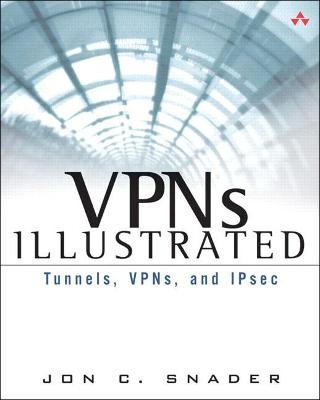
VPNs Illustrated
Addison-Wesley Educational Publishers Inc (Verlag)
978-0-321-24544-1 (ISBN)
- Keine Verlagsinformationen verfügbar
- Artikel merken
Virtual private networks (VPNs) based on the Internet instead of the traditional leased lines offer organizations of all sizes the promise of a low-cost, secure electronic network. However, using the Internet to carry sensitive information can present serious privacy and security problems. By explaining how VPNs actually work, networking expert Jon Snader shows software engineers and network administrators how to use tunneling, authentication, and encryption to create safe, effective VPNs for any environment.
Using an example-driven approach, VPNs Illustrated explores how tunnels and VPNs function by observing their behavior "on the wire." By learning to read and interpret various network traces, such as those produced by tcpdump, readers will be able to better understand and troubleshoot VPN and network behavior.
Specific topics covered include:
Block and stream symmetric ciphers, such as AES and RC4; and asymmetric ciphers, such as RSA and EIGamal
Message authentication codes, including HMACs
Tunneling technologies based on gtunnel
SSL protocol for building network-to-network VPNs
SSH protocols as drop-in replacements for telnet, ftp, and the BSD r-commands
Lightweight VPNs, including VTun, CIPE, tinc, and OpenVPN
IPsec, including its Authentication Header (AH) protocol, Encapsulating Security Payload (ESP), and IKE (the key management protocol)
Packed with details, the text can be used as a handbook describing the functions of the protocols and the message formats that they use. Source code is available for download, and an appendix covers publicly available software that can be used to build tunnels and analyze traffic flow.
VPNs Illustrated gives you the knowledge of tunneling and VPN technology you need to understand existing VPN implementations and successfully create your own.
Jon C. Snader is a TCP/IP and VPN expert whose background includes work in communications, networking, compiler development, operating systems, and radio network controllers.
Preface xiii Part 1. Background 1 Chapter 1. Introduction 3 1.1 Purpose 3
1.2 Readers 4
1.3 Typographical Conventions 4
1.4 Source Code and Third-Party Programs 5
1.5 Testbed 5
1.6 Road Map 6
1.7 Summary 8
Chapter 2. TCP/IP Overview 9 2.1 Introduction 9
2.2 Layering 9
2.3 Encapsulation 11
2.4 Addressing 13
2.5 IP 20
2.6 UDP 22
2.7 TCP 24
2.8 ICMP 31
2.9 NAT and Private IP Addresses 35
2.10 PPP 40
2.11 IPv6 43
2.12 Routing 47
2.13 Summary 54
Exercises 55
Chapter 3. Cryptography Overview 57 3.1 Introduction 57
3.2 Symmetric Ciphers 58
3.3 Asymmetric Ciphers 69
3.4 Cryptographic Hash Functions, MACs, and HMACs 75
3.5 Digital Signatures 80
3.6 Certificates 83
3.7 Summary 87
Exercises 88
Chapter 4. Tunnels 89 4.1 Introduction 89
4.2 IP-in-IP Tunnels 92
4.3 PPPoE 95
4.4 GRE 100
4.5 PPTP 104
4.6 L2TP 109
4.7 MPLS 135
4.8 gtunnel 145
4.9 Summary 151
Exercises 152
Part 2. Tunnels and VPNs 153 Chapter 5. Virtual Private Networks 155 5.1 Introduction 155
5.2 PPTP 157
5.3 L2TP 158
5.4 Other VPNs 162
5.5 Summary 163
Exercises 163
Chapter 6. Secure Sockets Layer 165 6.1 Introduction 165
6.2 Cipher Suites 166
6.3 The SSL Protocol 167
6.4 SSL on the Wire 171
6.5 OpenSSL 191
6.6 The stunnel Program 196
6.7 SSL Security 204
6.8 Summary 205
Exercises 205
Chapter 7. SSH 207 7.1 Introduction 207
7.2 The SSHv1 Protocol 208
7.3 The SSHv2 Protocol 232
7.4 Building VPNs with SSH 260
7.5 Summary 266
Exercises 266
Chapter 8. Lightweight VPNs 267 8.1 Introduction 267
8.2 VTun 267
8.3 CIPE 272
8.4 Tinc 283
8.5 OpenVPN 292
8.6 Summary 302
Exercises 302
Part 3. IPSec 305 Chapter 9. IPsec 307 9.1 Introduction 307
9.2 An Overview of IPsec 308
9.3 Road Map for Part 3 308
9.4 Summary 309
Exercises 310
Chapter 10. IPsec Architecture 311 10.1 Introduction 311
10.2 Protocols 312
10.3 IPsec Modes 313
10.4 Security Associations 316
10.5 Combining Security Associations 318
10.6 Policies 320
10.7 IPsec Processing 321
10.8 Summary 323
Exercises 324
Chapter 11. AH 325 11.1 Introduction 325
11.2 The AH Header 326
11.3 Sequence Numbers 328
11.4 AH Processing 330
11.5 Transport Mode 331
11.6 Tunnel Mode 333
11.7 AH with IPv6 336
11.8 Summary 338
Exercises 338
Chapter 12. ESP 341 12.1 Introduction 341
12.2 The ESP Header 342
12.3 ESP Processing 344
12.4 Transport Mode 345
12.5 Tunnel Mode 348
12.6 ESP with IPv6 353
12.7 Summary 354
Exercises 355
Chapter 13. IKE 357 13.1 Introduction 357
13.2 ISAKMP 358
13.3 IKE 375
13.4 An Example Negotiation 388
13.5 Summary 393
Exercises 394
Chapter 14. IPsec Futures 397 14.1 Introduction 397
14.2 IPsec Architecture 398
14.3 AH 401
14.4 ESP 403
14.5 IKE 404
14.6 NAT Traversal 409
14.7 Summary 416
Exercises 416
Appendix A Source Code 419 A.1 Introduction 419
A.2 Cryptographic Routines 419
A.3 Library Code 423
Appendix B Miscellaneous Software 425 B.1 Netcat 425
B.2 tcpdump and Other Packet Sniffers 426
B.3 ssldump 429
B.4 PPP 431
Bibliography 435 Index 445
| Erscheint lt. Verlag | 3.11.2005 |
|---|---|
| Verlagsort | New Jersey |
| Sprache | englisch |
| Maße | 188 x 234 mm |
| Gewicht | 950 g |
| Themenwelt | Mathematik / Informatik ► Informatik ► Netzwerke |
| ISBN-10 | 0-321-24544-X / 032124544X |
| ISBN-13 | 978-0-321-24544-1 / 9780321245441 |
| Zustand | Neuware |
| Haben Sie eine Frage zum Produkt? |
aus dem Bereich


